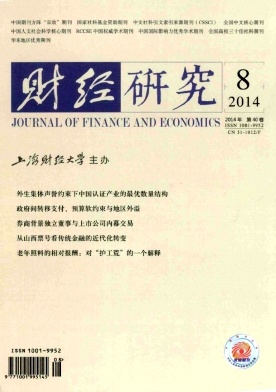信贷约束与外资溢出效应问题研究——基于中国工业企业数据的实证分析
财经研究 2014 年 第 40 卷第 08 期, 页码:30 - 41
摘要
参考文献
摘要
此文采用中国工业企业数据库的40多万家企业2002-2007年的非平衡面板数据,实证检验了外资的溢出效应以及信贷约束对外资溢出效应的影响。研究结果表明,在相同的行业和相同的省份内,不论是来自港、澳、台的外资还是来自于其他地区的外资,都对国内企业(包括国有企业和非国有企业)产生了显著的溢出效应。进一步的实证分析发现,信贷约束阻碍了外资的溢出效应,行业的信贷约束程度越高,则同行业和同省份内外资对国内企业的溢出效应就越小,相关的稳健性检验也支持上述结论。因此,我国应加快推进金融市场改革进程,为企业提供更好的经营环境。
[1]白重恩,路江涌,陶志刚.国有企业改制效果的实证研究[J].经济研究,2006,(8):4-13.
[2]陈琳,林珏.外商直接投资对中国制造业企业的溢出效应:基于企业所有制结构的视角[J].管理世界,2009,(9):24-33.
[3]陈涛涛,陈娇.行业增长因素与我国FDI行业内溢出效应[J].经济研究,2006,(6):39-47.
[4]韩旺红,马瑞超.FDI、融资约束与企业创新[J].中南财经政法大学学报,2013,(2):104-110.
[5]聂辉华,江艇,杨汝岱.中国工业企业数据库的使用现状和潜在问题[J].世界经济,2012,(5):142-158.
[6]潘文卿.外商投资对中国工业部门的外溢效应:基于面板数据的分析[J].世界经济,2003,(6):3-7.
[7]平新乔,吴晓静,邓永旭,等.外国直接投资对中国企业的溢出效应分析:来自中国第一次全国经济普查数据的报告[J].世界经济,2007,(8):3-13.
[8]夏业良,程磊.外商直接投资对中国工业企业技术效率的溢出效应研究——基于2002-2006年中国工业企业数据的实证分析[J].中国工业经济,2010,(7):55-65.
[9]许和连,魏颖绮,赖明勇,等.外商直接投资的后向链接溢出效应研究[J].管理世界,2007,(4):24-31.
[10]Abraham F,Konings J,Slootmaekers V.FDI spillovers in the Chinese manufacturing sector[J].Economics of Transition,2010,18(1):143-182.
[11]Agarwal N,Milner C,Riano A,Credit constraints and spillovers from foreign firms in China[J].Journal of Banking&Finance,Forthcoming
[12]Alfaro L,Chanda A,Kalemli-Ozcan S,et al.FDI and economic growth:The role of local financial markets[J].Journal of International Economics,2004,64(1):89-112.
[13]Ayyagari M,Demirgüc-Kunt A,Maksimovic V.Firm innovation in emerging markets:The role of finance,governance,and competition[J].Journal of Financial and Quantitative Analysis,2011,46(6):1545-1580.
[14]Braun M.Financial contractibility and assets′hardness:industrial composition and growth[R].Harvard University Working Paper,2002.
[15]Braun M,Larrain B.Finance and the business cycle:International,inter-industry Evidence[J].The Journal of Finance,2005,60(3):1097-1128.
[16]Chen M,Guariglia A.Internal financial constraints and firm productivity in China:Do liquidity and export behavior make a difference?[J].Journal of Comparative Economics,2013,41(4):1123-1140.
[17]Cohen W M,Levinthal D A.Absorptive capacity:A new perspective on learning and innovation[J].Administrative Science Quarterly,1990,35(1):128-152.
[18]Dollar D,Wei S J.Das(wasted)Kapital:Firm ownership and investment efficiency in China[R].NBER Working Paper No.13103,2007.
[19]Feenstra R C,Li Z,Yu M.Exports and credit constraints under incomplete information:Theory and evidence from China[R].NBER Working Paper No.16940,2011.
[20]Hale G,Long C.Are there productivity spillovers from foreign direct investment in China?[J].Pacific Economic Review,2011,16(2):135-153.
[21]Liu Z.Foreign direct investment and technology spillovers:Theory and evidence[J].Journal of Development Economics,2008,85(1):176-193.
[22]Manova K.Credit constraints,equity market liberalizations and international trade[J].Journal of International Economics,2008,76(1):33-47.
[23]Manova K.Credit constraints,heterogeneous firms,and international trade[J].Review of Economic Studies,2013,80(2):711-744.
[24]Rajan R G,Zingales L.Financial dependence and growth[J].American Economic Review,1998,88(3):559-586.
[25]Villegas-Sanchez C.FDI spillovers and the role of local financial markets:Evidence from Mexico[R].University of Houston,Manuscript,2009.
1规模以上的非国有工业企业主要指的是企业的主营业务收入在500万元及其以上的非国有工业企业,2011年该标准改为2 000万元及以上的企业(聂辉华等,2012)。
1 具体来说,这些行业主要包括了饮料制造业,金属制品,食品制造,家具,化工原料,钢铁,皮革制品,机械、电气,机械(除了电气),混杂、石油和煤炭产品,有色金属,其他化工品,其他非金属矿物品,纸及其制品,陶瓷,印刷出版,专业和科学设备,橡胶制品,纺织品,运输设备,衣服,木材等。
2 按照EFD指标来划分,信贷约束程度比较高的行业有塑料制品、科学设备、机械、运输设备以及能源等行业。而服装、皮革、烟草行业等信贷约束程度较低。
1限于文章篇幅,我们没有在文章中列出详细的估计结果,感兴趣的读者可以联系作者索取。
1 EFD_Median表示如果企业所处的行业在所有行业的信贷约束程度的中位数以上,取值为1,反之为0。其他两个指标的取值类似。
2 篇幅有限,我们只汇报了使用非国有企业进行估计所得出的结果。
3 限于文章篇幅,我们没有在文章中列出估计结果,感兴趣的读者可以联系作者索取。
[2]陈琳,林珏.外商直接投资对中国制造业企业的溢出效应:基于企业所有制结构的视角[J].管理世界,2009,(9):24-33.
[3]陈涛涛,陈娇.行业增长因素与我国FDI行业内溢出效应[J].经济研究,2006,(6):39-47.
[4]韩旺红,马瑞超.FDI、融资约束与企业创新[J].中南财经政法大学学报,2013,(2):104-110.
[5]聂辉华,江艇,杨汝岱.中国工业企业数据库的使用现状和潜在问题[J].世界经济,2012,(5):142-158.
[6]潘文卿.外商投资对中国工业部门的外溢效应:基于面板数据的分析[J].世界经济,2003,(6):3-7.
[7]平新乔,吴晓静,邓永旭,等.外国直接投资对中国企业的溢出效应分析:来自中国第一次全国经济普查数据的报告[J].世界经济,2007,(8):3-13.
[8]夏业良,程磊.外商直接投资对中国工业企业技术效率的溢出效应研究——基于2002-2006年中国工业企业数据的实证分析[J].中国工业经济,2010,(7):55-65.
[9]许和连,魏颖绮,赖明勇,等.外商直接投资的后向链接溢出效应研究[J].管理世界,2007,(4):24-31.
[10]Abraham F,Konings J,Slootmaekers V.FDI spillovers in the Chinese manufacturing sector[J].Economics of Transition,2010,18(1):143-182.
[11]Agarwal N,Milner C,Riano A,Credit constraints and spillovers from foreign firms in China[J].Journal of Banking&Finance,Forthcoming
[12]Alfaro L,Chanda A,Kalemli-Ozcan S,et al.FDI and economic growth:The role of local financial markets[J].Journal of International Economics,2004,64(1):89-112.
[13]Ayyagari M,Demirgüc-Kunt A,Maksimovic V.Firm innovation in emerging markets:The role of finance,governance,and competition[J].Journal of Financial and Quantitative Analysis,2011,46(6):1545-1580.
[14]Braun M.Financial contractibility and assets′hardness:industrial composition and growth[R].Harvard University Working Paper,2002.
[15]Braun M,Larrain B.Finance and the business cycle:International,inter-industry Evidence[J].The Journal of Finance,2005,60(3):1097-1128.
[16]Chen M,Guariglia A.Internal financial constraints and firm productivity in China:Do liquidity and export behavior make a difference?[J].Journal of Comparative Economics,2013,41(4):1123-1140.
[17]Cohen W M,Levinthal D A.Absorptive capacity:A new perspective on learning and innovation[J].Administrative Science Quarterly,1990,35(1):128-152.
[18]Dollar D,Wei S J.Das(wasted)Kapital:Firm ownership and investment efficiency in China[R].NBER Working Paper No.13103,2007.
[19]Feenstra R C,Li Z,Yu M.Exports and credit constraints under incomplete information:Theory and evidence from China[R].NBER Working Paper No.16940,2011.
[20]Hale G,Long C.Are there productivity spillovers from foreign direct investment in China?[J].Pacific Economic Review,2011,16(2):135-153.
[21]Liu Z.Foreign direct investment and technology spillovers:Theory and evidence[J].Journal of Development Economics,2008,85(1):176-193.
[22]Manova K.Credit constraints,equity market liberalizations and international trade[J].Journal of International Economics,2008,76(1):33-47.
[23]Manova K.Credit constraints,heterogeneous firms,and international trade[J].Review of Economic Studies,2013,80(2):711-744.
[24]Rajan R G,Zingales L.Financial dependence and growth[J].American Economic Review,1998,88(3):559-586.
[25]Villegas-Sanchez C.FDI spillovers and the role of local financial markets:Evidence from Mexico[R].University of Houston,Manuscript,2009.
1规模以上的非国有工业企业主要指的是企业的主营业务收入在500万元及其以上的非国有工业企业,2011年该标准改为2 000万元及以上的企业(聂辉华等,2012)。
1 具体来说,这些行业主要包括了饮料制造业,金属制品,食品制造,家具,化工原料,钢铁,皮革制品,机械、电气,机械(除了电气),混杂、石油和煤炭产品,有色金属,其他化工品,其他非金属矿物品,纸及其制品,陶瓷,印刷出版,专业和科学设备,橡胶制品,纺织品,运输设备,衣服,木材等。
2 按照EFD指标来划分,信贷约束程度比较高的行业有塑料制品、科学设备、机械、运输设备以及能源等行业。而服装、皮革、烟草行业等信贷约束程度较低。
1限于文章篇幅,我们没有在文章中列出详细的估计结果,感兴趣的读者可以联系作者索取。
1 EFD_Median表示如果企业所处的行业在所有行业的信贷约束程度的中位数以上,取值为1,反之为0。其他两个指标的取值类似。
2 篇幅有限,我们只汇报了使用非国有企业进行估计所得出的结果。
3 限于文章篇幅,我们没有在文章中列出估计结果,感兴趣的读者可以联系作者索取。
引用本文
辛大楞, 车维汉. 信贷约束与外资溢出效应问题研究——基于中国工业企业数据的实证分析[J]. 财经研究, 2014, 40(8): 30–41.
导出参考文献,格式为:





 7343
7343  3959
3959

